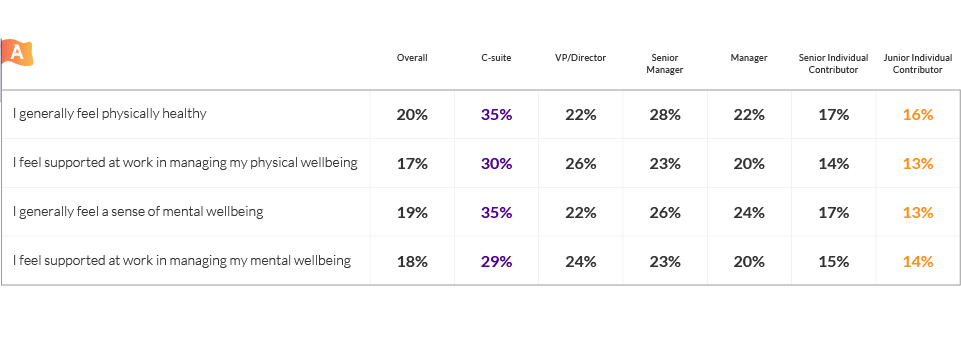Create a culture that means business™
Email address
From belonging to equity, latest research uncovers the needs that aren’t being met for your most at-risk cohort
There is a great deal of focus on retaining employees and managers now that HR leaders are feeling the ripple effects of the Big Quit. Four million people resigned in July, in America, alone! According to our own research here at the Achievers Workforce Institute (AWI), 86% of employees, including junior team members, sometimes think about looking for a job elsewhere. We decided to zoom in on some of the reasons why, with a particular focus on employees in early stages of their career, to provide HR leaders with some insight on how to turn their most at-risk cohort into a safeguard for future business through improving wellbeing at work.
At AWI, we believe that employers need to take a data-driven approach to understand their employees, so that a sense of meaning and purpose at work can be co-created between organizations and their people. We asked 3,000 global respondents across various age groups, seniority levels, genders, industries, and ethnic backgrounds about their wellbeing at work. What we heard from junior employees is there are some significant gaps in their needs being met. Let’s take a closer look.
The wellbeing gap
While many leaders believe they are recognizing employees for their wellbeing behaviors, that action isn’t being perceived by junior team members. In fact, AWI uncovered a major gap. Specifically, 36% of C-suite respondents believe employees receive recognition for taking care of their wellbeing, compared to just 12% of junior individual contributors reporting that they actually do receive that kind of recognition.


If there’s a misperception that junior staff are receiving the kind of wellbeing supports they need, what can HR leaders do to close the gap? In this piece, we identify belonging, stress, and equity as critical factors, and offer tips and guidelines for improving wellbeing at work for junior employees.
It begins with belonging
Job level is an important factor to consider when tracking how needs are being met for job satisfaction, engagement, and belonging with a particular cohort. Each will have different needs in terms of career planning, work-life balance, and coaching — and junior team members should never be an exception.
Yet only 15% of junior contributors feel a strong sense of belonging. This is much lower than the 26% average, and the lowest percentage of all groups, making junior contributors the most at-risk cohort for not feeling like they belong to the organization. That’s an insight that HR leaders really need to lean into.
“I feel a strong sense of belonging at my organization.”

Please note: this data is specifically about job level and career stage and is not a reflection of age.
To understand the specifics underpinning this significant difference in the belonging gap, we first need to understand what makes up belonging. In AWI’s Belonging at Work Culture Report, five distinct pillars of belonging were identified: feeling welcomed, known, included, supported, and connected. The data on junior contributors consistently show the lowest percentages for all five areas. This is astounding new information that simply can’t be ignored.
This segment of the employee population is 23% less likely to feel known, 30% less likely to feel valued, and up to 41% less likely to say they have a supportive manager. With just 10% saying their needs are being met by DEI efforts and only 14% believing that their pay is equal to others at the same level, it’s no wonder why 86% sometimes think about looking for a job elsewhere. What’s more, 27% say they have never been recognized, which we know through research is a key driver of belonging.
The bottom line is that relative to this lack of belonging, just 16% of junior individual contributors are highly engaged. To really envelop your junior-level employees into the fold of your organization, be sure to focus on the pillars of belonging and ensure that you are doing a great job of welcoming, knowing, including, supporting, and connecting with them. You’ll find a checklist included in AWI’s Belonging at Work Culture Report to help you on your journey to ensuring junior team members feel as though they are a meaningful part of the organization.
Address the stress
According to our research, senior leaders are most likely to feel healthy, but are also more likely to have taken stress leave. More specifically, C-suite leaders are twice as likely as junior independent contributors to say they feel physically and mentally healthy and are almost twice as likely to have taken stress leave.

With junior workers just as likely as average to experience stress, our research found that they are less likely to feel capable of managing it or to take time off work — and less likely to say they have a good work-life balance. Stress management tools and support must be made readily available.
How can employers address stress in the workplace if there isn’t a clear answer to what impacts stress levels? Some immediate steps you can take include introducing a stress management training course or a quarterly stress management speaker. For your longer-term strategy, the experts at Achievers have developed a list of top 5 initiatives that HR leaders can begin to adopt now to create a brighter future for those in the early stages of their career.
1. Ask employees and take action
Talk to employees about their stress levels and what they need, then implement changes based on feedback provided. Employees who said their employer took action on feedback were 17% less likely to be stressed. Just 18% of employees say their organization does this. Your employees are experts in terms of both their stressors and their needs, so tap into their insights and experience.
2. Monitor workloads
Workload is a major driver of stress. Ensure your employees have manageable workloads by monitoring to-do lists and looking at ad hoc requests that are adding to tasks without strategic value. Enable employees to push back on tasks if it will require them to work longer hours or manage too many projects. One example of a helpful way to frame new requests is: “If a new task is taken on this week, what can we delay to next week or month?”
3. Encourage downtime
True downtime is vital for reducing stress and preventing burnout. Allow workers to switch off outside of work hours by being clear that there is no expectation to reply to emails or messages that arrive after hours. Encourage use of vacation time and model work-life balance from the top. If managers and senior leaders are taking leave and switching off from emails, it sends a positive message to employees, giving them permission to do the same.
4. Ensure role clarity
One of the biggest drivers of stress is lack of clarity around role and tasks. When it isn’t clear what an employee is responsible and accountable for, or what objectives they are being assessed upon, then levels of fear, uncertainty, doubt, and stress are raised. Maintain up-to-date job descriptions and specific objectives and make it easy for employees to clarify any questions they have about their roles and responsibilities.
5. Communicate to reduce uncertainty
Finally, ensure ample, accurate communication to reduce areas of uncertainty. As the pandemic continues and organizations navigate different ways of working, stress levels remain high for many employees. Communication as a powerful driver of workplace resilience during times of stress. Communicate frequently, transparently, and honestly about challenges and solutions that the organization is working through to reduce both uncertainty and resulting stress.
It’s important to remember that stress is a relative experience with negative impacts, regardless of job level or position. While senior leaders may have more accountability and responsibility, they also have years of experience to help them cope with these job stresses. Junior workers need additional support. Whether that is informing them of the option to take leave if needed, or mentoring to help them develop stress management skills, organizations have a responsibility to take better care of workers at all levels.
It ends in equity
Employees with a strong sense of belonging are more than twice as likely to say that employees have the same opportunities as others and that their compensation is similar to others at the same level. Remember, there can be many factors at work for those who feel a sense of belonging. Those in early stages of their career can also happen to be a part of one or more marginalized groups. Sometimes a hybrid of supports is appropriate.
Support employees with disabilities by including them in progressive accessibility initiatives
With one in five employees reporting they have a disability, supporting this group in the workplace is key to better business outcomes. To better support, create an environment that reduces unconscious bias and ableist language, and consider introducing sensitivity training for all employees, but especially managers who lead teams.
Ensure the workplace is accessible, both physical and virtual – and be discreet but not secretive. Normalize accommodations without making a spectacle out of them, and work with disabled employees to keep coworkers appropriately in the loop. Also, involve affected groups in policy development and ask for feedback from all employees using surveys, anonymous Q&A sessions, chatbots, and other voice-of-employee tools to gather information on challenges and opportunities to improve conditions for all workers.
Ensure women feel welcome and connected – it’s incredibly important to them
According to our research, women benefit less than men on wellbeing factors, indicating a need for organizations to improve how they are meeting women’s needs in the workplace. So, what can employers do to improve a sense of wellbeing and belonging for women at work?
To begin, ensure they truly feel welcome. Our study found that feeling warmly welcomed at work is particularly important to women, with two-thirds saying it contributes to their feeling of wellbeing.
Connection is another crucial element that fosters a sense of belonging and wellbeing for women. In fact, 51% of women rated having strong connections and friendships at work highly.
Women are 24% less likely to have been recognized by their manager in the last week when compared to men. Managers should be trained on the importance of meaningful recognition to ensure they understand the role they play in engaging junior employees who are women.
Understand that BIPOC employees most desire working from anywhere
Respondents who self-identified as belonging to a racial minority group were almost a third more stressed than average. Employers should look closely at equity regarding workloads and other work-related stress factors.
Work-from-home options are especially valued by BIPOC respondents. This cohort is 25% more likely to say they would consider looking for a new job if they can’t work remotely. This is higher than any other group surveyed. Bloomberg reports that Black employees were 55% more likely to say they were treated fairly at work in 2021 than in 2020. Experts interviewed for the article suggest that a reduction in microaggressions and improving the ability to set boundaries at work could be some of the factors involved.
Although workload and work-from-anywhere options are important to consider, it’s paramount to seek more specific feedback directly from your employees to identify even more ways to support workplace success for your junior employees who are BIPOC.
Cultivate a culture of true inclusion with, and for, LGBTQ+ employees
LGBTQ+ workers reported slightly higher rates of stress than average (56% versus 48%) but, most notably, were considerably less likely to say they felt capable of managing that stress. They were also 55% more likely to have taken stress leave, compared to the overall average.
Beyond stress, LGBTQ+ respondents rated feeling included as the number-one factor contributing to their feelings of wellbeing at work. To ensure a welcoming environment, introduce specific diversity and inclusion training, create inclusive policies, use inclusive language, ask for feedback and act on it, and support employee resource groups (ERG). This advice was arrived at with input from Achievers Proud, an ERG that ensures Achievers maintains a forward-thinking, inclusive, and safe environment for all LGBTQ+ employees. It is invaluable guidance for cultivating a culture of true inclusion for junior employees who identify as LGBTQ+.
Well on your way to wellbeing
By focusing on improving conditions for junior individual contributors, employers are actually investing in the future of good employee wellbeing. Reducing stress, absenteeism, and turnover is an excellent way to transform your most at-risk cohort into a safeguard for future business.
More on how to support junior employees, marginalized groups at work, and the wellbeing of all employees is outlined in the AWI Empowering Employee Wellbeing in the New World of Work, a valuable resource that we highly recommend for your employee engagement strategy. Download your copy today to get all of the details and insight this latest research has to offer for your approach to supporting the wellbeing of your junior employees as part of your employee engagement strategy.

